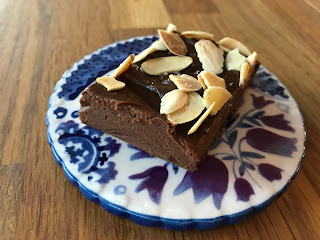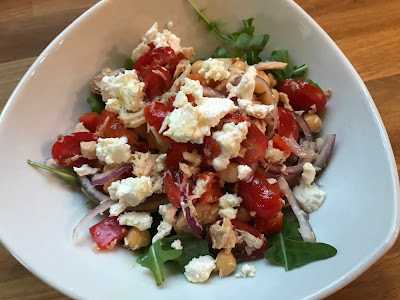

These are the hot cross buns I made for Easter. I’m still looking for dishes to create what will eventually be my standard Easter menu, where I won’t have to rack my brain each year for something special, and these buns make the cut. I didn’t make deviled eggs this year, since eggs were so scarce, but this was a very worthwhile use of those I had! These buns are closer to the European version of hot cross buns, where a sort of custard dough is piped onto the buns before baking, instead of the American version, where the baked buns are glazed with icing once cooled. They appealed to me more, and everyone liked them! Even the Little Prince, who will always pick raisins and dried cranberries out of his baked good, ate the tiny currants without any trouble.
The recipe is from
The Kitchn and my modifications are below. (For example, I used honey instead of golden syrup, because it was a last-minute menu and I just didn’t have time to source golden syrup.) I included photos of the process, because it’s so much clearer to me when I can see what I’m supposed to be doing, especially for the crossing part! The recipe yields 24 buns; they keep well for a few days in an airtight container, but you could also freeze some of them. Calculate about 3 hours start-to-finish to make them, and don’t be put off by the length of the recipe – they’re worth it!
For the buns
1 ¼ cups lactose-free milk
2 (¼-oz) packets of active dry yeast (4 ½ tsp.)
¾ cup plus 1 tsp. granulated sugar, divided
3 cups bread flour
2 cups all-purpose flour, plus more for dusting
2 tsp. finely grated fresh lemon zest (from 1 lemon)
2 tsp. finely grated fresh orange zest (from 1 orange)
1 tsp. ground cinnamon
1 tsp. salt
¼ tsp. ground nutmeg, or 6 to 10 scrapes from a whole nutmeg
1 ½ sticks (6 oz or ¾ cup) lactose-free butter, melted and cooled slightly
4 large eggs
2 large egg yolks
1 tsp. vanilla extract or vanilla bean paste
1 cup dried currants or raisins
For the crossing mixture
1 cup all-purpose flour
1/3 cup granulated sugar
¼ tsp. salt
1 large egg, lightly beaten
5 Tbsp. lactose-free milk
¼ tsp. vanilla extract
For the egg wash
1 large egg
1 tsp. water
For the glaze
1/3 cup Lyle's Golden Syrup, or apple or apricot jelly (I used honey)
2 Tbsp. water
For the buns
Place the milk in a small saucepan over low heat until warm to the touch but not hot (between 105 °F and 115 °F on an instant-read thermometer), about 6 minutes. Transfer to the bowl of a stand mixer fitted with the paddle attachment.
Add the yeast and 1 teaspoon of the sugar. Mix on low speed until just combined, about 20 seconds. Let stand in the bowl until the mixture is foamy, frothy, smells distinctly like yeast, and is beige in color, 5 or 6 minutes.
Meanwhile, place the bread flour, all-purpose flour, lemon and orange zest, cinnamon, salt, nutmeg, and remaining ¾ cup sugar in a large bowl and whisk until combined.
Add half of the flour mixture to the yeast mixture and mix on low speed until just combined, about 1 minute. Add the butter, whole eggs, egg yolks, and vanilla, and mix on low speed to combine, about 1 minute. Add the remaining flour mixture and mix on low speed to combine, about 1 minute.
Switch from the paddle attachment to the dough hook attachment. Mix on medium speed until the dough comes together, is smooth, and can be easily scraped down with a dough scraper, about 5 or 6 minutes; it won’t completely clear the side of the bowl and will remain just a little sticky. (I had to add a little flour here to help things along.)
Add the currants and mix on low speed until evenly distributed throughout the dough, about 1 minute.
Scrape the dough into a large, clean bowl. Cover with plastic wrap or a kitchen towel; let rise in a warm, draft-free spot until the dough has almost doubled in size, 1 to 1 ½ hours (I like to do this in the microwave, with the door slightly ajar).

Meanwhile, line a 13”x18” rimmed baking sheet with parchment paper (mine was 12”x17”); set aside. Lightly flour a work surface.
When the dough is ready, transfer it to the work surface and divide it into 24 pieces (about 2 ½ ounces or a heaping ¼ cup each). Roll 1 piece of dough into a ball (if the dough is too sticky, dust your hands very lightly with flour) and place on the prepared baking sheet, about ¾” from the edge. Repeat with the remaining dough, placing balls ¾” apart, making 4 rows across and 6 rows down the length of the sheet. Flatten the balls with lightly floured fingers so that they are each about 2” in diameter.
Spray 2 large sheets of plastic wrap with cooking spray and place them side by side over the buns, sprayed-side down. Set aside in a warm place to let the buns rise until they are just barely touching, 40 minutes to 1 hour (obviously, at this point they no longer fit in my microwave, but I left them on the stovetop with the plastic wrap on).
For the crossing mixture
Meanwhile, place the flour, sugar, and salt in a medium bowl and whisk to combine. Add the egg, milk and vanilla and stir into a smooth, thick paste. Transfer into a piping bag fitted with a plain small tip with a ¼” opening (you can also use a resealable plastic bag from which you snip a tiny corner). Pro tip: prop up your pastry bag in a tall glass in order to fill it without making a mess!

About 20 minutes before the end of the second rise, arrange a rack in the center of the oven and preheat it to 350 °F.
Uncover the buns. Using a ruler as a guide if necessary, run a sharp knife down the center of each row and column of buns, slashing the tops about 1/8” deep. When finished, each bun should have a cross from end to end.

Squeeze a line of the crossing mixture into the slashes on each bun, following the grooves from bun to bun and edge to edge, so that the top of each bun has a filled cross. You may have some leftover filling.
 For the egg wash
For the egg wash
Whisk the egg and water together in a small bowl. Gently but thoroughly brush the buns with the egg wash, avoiding brushing the filling.
Bake the buns until they are deep golden brown and an instant-read thermometer inserted in the middle registers between 195 °F and 200 °F, about 20 minutes.
 For the glaze
For the glaze
Meanwhile, place the syrup and water in a small saucepan and heat over medium-low heat, stirring occasionally, until the jelly is fully dissolved and the mixture is warm (this can also be done in a microwave-safe bowl heated about 30 seconds; stir the mixture until thoroughly combined). Set aside.
Place the baking sheet on a wire rack. Immediately use a clean pastry brush to coat the buns well with the glaze.

Let the buns sit in the pan and cool at least 30 minutes before serving.
























































